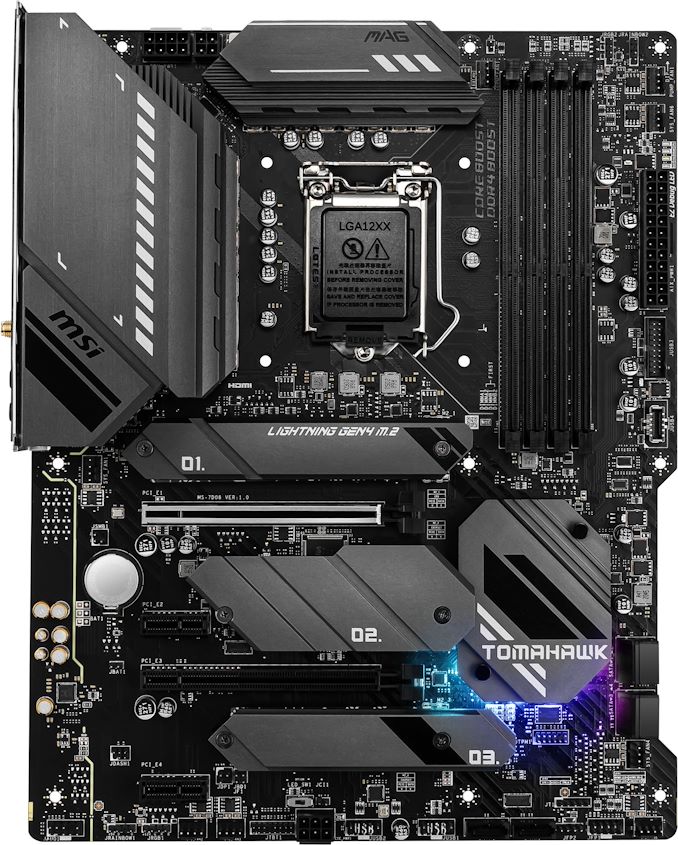The Intel Z590 Motherboard Overview: 50+ Motherboards Detailed
by Gavin Bonshor on January 19, 2021 10:15 AM ESTMSI MAG Z590 Tomahawk WIFI
The Tomahawk series has been well regarded as one of the most cost-effective boards when considering both features and price points. For Z590, MSI looks to have gone a slightly different route and equipped it towards the mid-range, with plenty of competitive controllers and specifications. The MSI MAG Z590 Tomahawk is advertised with a large 16-phase power delivery and follows a black and dark gray color scheme throughout. MSI has gone as far as numbering its M.2 heatsinks, which resembles a militaristic theme that is fitting, as it hails from its Arsenal gaming series.
The MSI MAG Z590 Tomahawk's features include two full-length PCIe slots, with one full-length PCIe 4.0 x16, a second full-length PCIe 3.0 x4 slot, and two PCIe 3.0 x1 slots. Similar to its MPG series of boards, the Z590 Tomahawk WiFi has three M.2 slots, each with heatsinks, and includes one PCIe 4.0 x4 and two PCIe 3.0 x4/SATA slots. MSI splits up the location of the SATA ports, with four right-angled connectors in an X-shaped cutout on the PCB, with two straight-angled ports located at the bottom. All six of the SATA ports include support for RAID 0, 1, 5, and 10 arrays. Memory support is impressive, with speeds of up to DDR4-5333 and up to 128 GB of capacity across four memory slots.
The MSI MAG Z590 Tomahawk WiFi includes one USB 3.2 G2x2 Type-C, one USB 3.2 G2 Type-A, four USB 3.2 G1 Type-A, and two USB 2.0 ports. MSI includes a premium Intel pairing with its latest AX210 Wi-Fi 6E interface and a single I225-V 2.5 GbE controller for networking. Onboard audio is powered by an unspecified Realtek HD audio codec, with five 3.5 mm audio jacks and S/PDIF optical output included. Two video outputs include one DisplayPort 1.4 and one HDMI 2.0b. Finishing off the rear panel, which includes a pre-attached I/O shield, is a tiny BIOS Flashback button.
MSI has set an MSRP of $239 for the MAG Z590 Tomahawk WiFi, which is more than it was for the launch of Z490. Despite this, the Tomahawk is no longer a bridge between the entry-level and the mid-range; it's a solid mid-range model. It has plenty to offer for the price, including premium 2.5 GbE and Wi-Fi 6E networking, as well as three M.2 slots and USB 3.2 G2x2 Type-C.












88 Comments
View All Comments
Oxford Guy - Tuesday, January 19, 2021 - link
You’ll never be able to block all the spyware with a firewall. Windows is just one component of it. Don’t forget things like stealth CPUs that are built into the CPU, like the little friend on Lando’s shoulder. Etc.lmcd - Tuesday, January 19, 2021 - link
What, the tinfoil hat isn't enough anymore? The "spyware" is just as present on any Windows era.If you want to disable built in telemetry, pay for pro and disable it in the registry. It's not hard if you're really that into privacy.
Spunjji - Wednesday, January 20, 2021 - link
@lmcd - but that would require *effort* - why waste that effort on customising a modern OS, when he could expend more effort cobbling together a barely-working platform on a 12-year-old one? 😂Makaveli - Wednesday, January 20, 2021 - link
lol all I saw in my head reading those post are "old man yells at clouds"Oxford Guy - Friday, January 22, 2021 - link
That’s due to the fact that the old man has just as much chance of getting the spyware out of Windows and CPUs (and the rest) as you lot have a chance of saying something relevant.Oxford Guy - Friday, January 22, 2021 - link
Call us when the shuttle lands, Pauline.Slash3 - Tuesday, January 19, 2021 - link
Z590 only provides six native SATA ports.ASRock's Z590 Taichi has eight ports, with two via an ASMedia ASM1061 controller.
Silver5urfer - Wednesday, January 20, 2021 - link
Got it thanks. I suppose that's how the EVGA Dark got it's 8 SATA ports too.weilin - Thursday, April 29, 2021 - link
Z590, if i remember correctly... has 30 HSIO lanes total:6 of which are dedicated to USB (and can be ganged in pairs for 20Gb/s ports)
4 more that is either USB 10Gb/s or 5Gb/s or PCIe.
2 of them which can be Ethernet or PCIe,
2 of them which can be SATA, Ethernet, or PCIe.
6 of them which can be SATA or PCIe.
10 dedicated PCIe
So everything all together means theoretically maximum of:
4 LAN ports
8 SATA ports
10 USB ports
24 PCIe ports
It's up to motherboard manufacturers to configure them as they see fit. It seems like the popular choice is to maximize USB, leave SATA at 6 and put the rest on PCIe ports (take 1 or 2 away for Ethernet, and 4 away for Thunderbolt if present).
weilin - Thursday, April 29, 2021 - link
If anyone's interested in see the doc:https://ark.intel.com/content/www/us/en/ark/produc...
On to left its under "Technical Documentation" -> "Intel® 500 Series Chipset Family Platform Controller Hub Datasheet, Volume 1 of 2" -> bottom of page 18